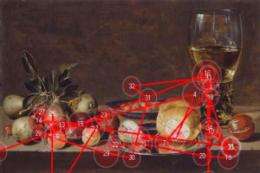Research to determine whether art is in the eye of the beholder

(PhysOrg.com) -- Scientists from the University of Manchester are to transform a leading art gallery into a laboratory to determine whether or not people experience art in the same way.
Under normal circumstances it's impossible to know whether any two people look at the same parts of a painting or whether their attention is drawn to different elements.
But now researchers from the University's School of Computer Science and Manchester Art Gallery are planning to use state-of-the-art technology to determine whether reaction to art is a common experience.
They will use infra-red technology to determine the order that people look at different elements in a series of 12 paintings from the gallery, as well as the length of time they spend looking at them.
The findings will suggest for the first time whether or not we all look at art in the same way or whether our experience is more individual.
And the researchers - led by Dr Simon Harper, Dr Caroline Jay and Dr Andrew Brown - believe the findings could have implications for the way websites are designed in the future.
"This is exploratory work in which we are looking for patterns in the way people look at different visual elements," said Dr Jay.
"We can't yet say if there's a definitive order that people look at things. But this may help us to understand how and why people focus on particular areas in sequence, what attracts them and what is the deciding factor for this sequencing.
"It may be that with portraits people are drawn to the eyes, for example, but we don't know. And with abstracts we don't know whether there will be any similarity between the eye tracks at all.
"The findings will help us decide the order in which we present things. If people do experience these in similar ways then there is a design message. This may inform the design of websites."
Dr Harper and Dr Jay believe the findings of this ViSAS research (Visual Serialisation for Auditory Sequencing) could be of particular relevance to work on the 'translating' of web pages into an audio-described resource for blind users or for sites designed for mobile phone users.
Dr Harper said: "Common sense suggests that sighted and blind users of the World Wide Web do not share similar user experiences. However we propose the opposite and suggest that the user experiences of these two groups are directly linked.
"If sighted users focus of areas of a Web page in sequence, then understanding and predicting this sequence can allow a conversion from vision to audio via text-to-speech technology; and therefore create an equivalent experience between sighted and blind people."
The experiment will focus on a variety of paintings from Manchester Art Gallery's permanent collection, ranging from figurative to abstract and historic to contemporary works.
And Dr Harper says it's particularly fitting that it will coincide with an exhibition at the gallery focussed on Renaissance man Leonardo da Vinci, who was as talented a scientist as he was an artist.
The research will be carried out on members of the public, as well as staff from the gallery who are already familiar with the works.
And the scientists will be looking to determine whether familiarity has an impact on a person's experience of the artwork.
As part of the experiment, volunteers will be asked to sit in front of a computer screen, where the images of the paintings will be displayed.
Infra-red technology - calibrated to the individual - will then track the movement of the eye through the reflection of the light.
And the movement will be tracked and then mapped into a network of lines and dots that can be tracked on the screen - showing the movement of the eye and the length of time it remained focussed on a single point.
Dr Harper came up with the idea for the experiment after a visit to an art exhibition at another venue, where guides were very specific in their interpretation of the way visitors looked at paintings and the techniques employed by artists to draw in viewers in a particular way.
Staff at Manchester Art Gallery are keen to use the results to inform the ways they display artworks in the future.
In the future staff say the images of the eye tracks could be exhibited next to the works in the gallery. They believe these images will be interesting to visitors because they remind viewers of how many other people have looked at this work and because they have a beauty of their own.
Speaking about the experiment, Councillor Mike Amesbury, Executive Member for Culture and Leisure, said: “It’s great to see Manchester Art Gallery getting involved in such a cutting-edge and collaborative experiment.
“It’s a fascinating example of the radical spirit and pioneering ambition of many cultural attractions in the city.”
The team of computer scientists will be conducting the research at Manchester Art Gallery, on Mosley Street, in the city centre.
Provided by University of Manchester
















